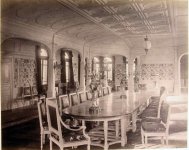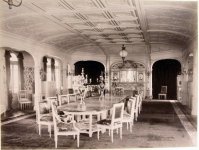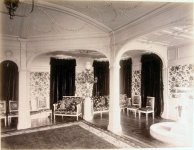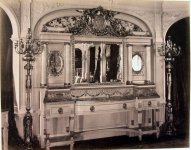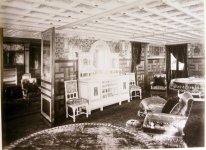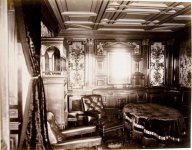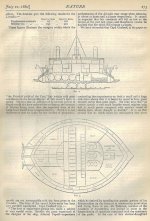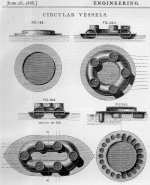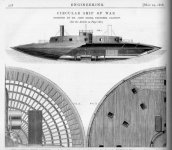In accordance with the 1856 Treaty of Paris, which formalized Russia's defeat in the Crimean War, Moscow was forbidden to deploy its fleet in the Black Sea. This did not fully suit the imperial government and by 1871 (the moment the agreement was denounced and Russia was given back its right to keep ships on the Black Sea) a program designed to create coastal defenses in Crimea, which would not be affected by the pact, was already in full swing.
"Thus, the authorities decided to build 'ships not from wood.' The draught of such a floating object had to be 3.3 meters and the guns had to have a caliber of at least 280 mm. One of the most important criteria of these ships was the armor - more than on the foreign vessels," explained former editor-in-chief of the Voenno-promyshlenny kurier newspaper Mikhail Khodaryonok.
The only vessels that met these criteria were the round battleships designed by Admiral Andrei Popov, hence the nickname Popovkas.

The existence of these two (yes, there were only two built... allegedly) round Russian armored ships in 1873 does not appear to be a widely known fact. As we came to find out, information is not really hidden, for it is publicly available for research. Yet, certain things are simply not being disseminated. Personally, I found these round ships significant enough to share on this blog. These two ships were:
Isn't it interesting how seemingly unrelated things could have a hidden meaning? Jumping ahead of myself, but considering the time frame, could it be that the design of these ships was acquired by the Admiral Popov during his San Francisco stay? Interesting that this idea of building "floating fortresses" in support of the Russian Black Sea defense forces is also being attributed to 1863.
So, who was this Admiral Popov. Here is how Wikipedia presents the narrative compliant version.
Small InconsistenciesThese small inconsistencies I'm talking about, pertain to the review of the capabilities of the ships. I will re-quote a portion of the above "Unconventional Designs" paragraph.
But here we have a totally contradicting (the above two) review published by Sir Edward Reed, then Director of Naval Construction of the Royal Navy.




The Livadia was an imperial yacht of the House of Romanov built in 1879–1880 to replace a yacht of the same name that had sunk off the coast of Crimea in 1878. The new Livadia, intended for service on the Black Sea, was a radically novel ship conceived by Vice Admiral Andrey Popov, designed by naval architect Erast Gulyaev and built by John Elder & Co. of Govan on the Clyde. The Livadia continued Popov's line of circular ships although this time Popov sacrificed geometrical perfection for seagoing capabilities. She had a beam of 153 ft (47 m) against overall length of only 259 ft (79 m). An extreme example of tumblehome architecture, she sported a conventionally shaped superstructure mounted on a wide, flat-bottomed, turbot-shaped submerged hull or pontoon.

Construction of the Livadia, "a gigantic life-size experiment" and a prototype for next-generation battleships, was supervised by William Pearce. Bruno Tideman and Edward James Reed acted as consultants, William Leiper and William De Morgan designed luxurious interiors. The Livadia turned out a surprisingly maneuverable and stable ship with a respectable maximum speed of 15.7 knots and her efficiency was comparable to conventional ships. Her performance at sea trials surprised most naval architects and was attributed to the favorable placement of the propellers.
The maiden voyage of the Livadia revealed that her wide flat bottom was highly prone to damage by wave slamming. She spent her brief career as a yacht in the docks and was used for her intended purpose only once, carrying Grand Dukes Constantine and Mikhail across the Black Sea. Alexander III had no interest in resurrecting an inherently flawed ship, and in August 1881 Livadia was moored in Nikolaev and then hulked and stripped of her former luxuries. Her engines were removed and reused on the Russian cruisers. The rusty hulk saw some use during World War I and was finally decommissioned in 1926.
So if the Yacht sucked that much (according to 2019 Wikipedia), then why in 1880 the following was published?
And then we have opinions like this Google translated one:
KD: To be honest, I do not know what to make out of the existence of these ships. Kinda getting that feeling when you are being told to move on, because there is nothing interesting to see here. To a certain degree, it looks like we are being forcefully convinced that these ships were terrible. At the same time several instances mentioned above make me question the narrative.
We do not appear to have any high resolution images of these ships, to take a good enough of a look. I was unable to find any serious construction documentation. On one hand it is understandable when time taken into consideration. On the other hand this is the same old story - nothing survived.
After reading the below wikipedia articles (which contain way more info), it becomes apparent that these ships were something more important comparing to what we are lead to believe. The description of their construction alone demonstrates their importance.
Judging by the general appearance of these ships sitting in the water, it's almost like they were redesigned for other purposes. May be, I don't know.
Circular Vessels of WarAnd as it often happens in the process of looking into something, additional things start popping up. Sometimes in great quantities. Round, or circular ships of this type were not as uncommon as it seems. But... it is not being advertised, and our school teachers prefer other "more important" issues. Who cares that the First Emperor Napoleon used to design ships?
Sources:
KD: Anyways, if you have any thoughts on the matter, please feel free to share.
"Thus, the authorities decided to build 'ships not from wood.' The draught of such a floating object had to be 3.3 meters and the guns had to have a caliber of at least 280 mm. One of the most important criteria of these ships was the armor - more than on the foreign vessels," explained former editor-in-chief of the Voenno-promyshlenny kurier newspaper Mikhail Khodaryonok.
The only vessels that met these criteria were the round battleships designed by Admiral Andrei Popov, hence the nickname Popovkas.
The existence of these two (yes, there were only two built... allegedly) round Russian armored ships in 1873 does not appear to be a widely known fact. As we came to find out, information is not really hidden, for it is publicly available for research. Yet, certain things are simply not being disseminated. Personally, I found these round ships significant enough to share on this blog. These two ships were:
- Мonitor Novgorod
- Мonitor Kiev (later Vice Admiral Popov)
Admiral Popov

1821-1898
This gentleman above was the one who designed the round ships. Before we briefly go over his bio, I wanted to remind, that he was one of the two Russian Imperial Navy commanders who "assisted" the United States during the Civil War. He commanded the Russia's Pacific Squadron which arrived in San Francisco on October 12, 1863.1821-1898
Isn't it interesting how seemingly unrelated things could have a hidden meaning? Jumping ahead of myself, but considering the time frame, could it be that the design of these ships was acquired by the Admiral Popov during his San Francisco stay? Interesting that this idea of building "floating fortresses" in support of the Russian Black Sea defense forces is also being attributed to 1863.
So, who was this Admiral Popov. Here is how Wikipedia presents the narrative compliant version.
- Synopsys: Andrei Popov (1821-1898) was an officer of the Imperial Russian Navy, who saw action during the Crimean War, and became a noted naval designer. Popov trained for the navy, and commanded ships before and during the Crimean War. He rose to the rank of rear-admiral and was assigned to supervise warship design and construction. He was in command of a squadron in the Pacific during the Polish Crisis that followed the January Uprising in 1863, and was sent to North America on a goodwill mission, and in order to raid colonial possessions should war break out between Russia and other European powers. Though there was no war, Popov spent a year in San Francisco, where the Russian presence had a distinct impact on life. Popov turned to warship design after his return to Russia, and proposed a series of warships to an unconventional circular design. Only two were built, one of which, Vice-admiral Popov, was named in honor of him. Their radical designs proved troublesome, and were not repeated.
- Early Life: Popov was born in Russia on 21 September 1821, and attended the Naval School. He entered the navy after graduating. He commanded a steamship during the Crimean War and was appointed Manager of Artillery Supplies at Sevastopol. When the war ended Popov was appointed to supervise the construction of steamships for the Russian Navy, a post he held for the next 30 years. The period saw a large expansion in naval construction, with Popov overseeing new Russian warships being built at St Petersburg, such as the 9,000 ton battleship Petr Velikyy.
- Unconventional Designs: Russia had been banned from maintaining a battlefleet in the Black Sea after the end of the Crimean War. Fearful of further naval incursions, Russia wanted a fleet of heavily armed shallow-draught coastal defence vessels to guard the Kerch Straits and the mouth of the Dniepr River. Popov built a 24-foot steamer and carried out tests in 1870, subsequently proposing a fleet of ten large circular coastal defence vessels. Their circular design would create a stable gun platform suitable for operations in the shallow water of the Black Sea and the Sea of Azov, and they were armed with two 11-inch guns. The expense involved meant that only two were built, the Novgorod and the Kiev. The Kiev was renamed Vice-admiral Popov in honour of her designer after being laid down. The unconventional designs received support from the British naval architect Sir Edward Reed, but failed to live up to expectations. Though heavily armoured, they were too slow to operate in the Dniepr, and were difficult to steer. Firing their guns caused them to spin round, even with the rudder hard over and contra-rotating some of their six propellers. They could not cope with rough weather and were prone to rolling and pitching, which prevented the aiming and loading of the guns. Though they were judged failures, the circular hull design, tempered with a conventional bow and stern, was repeated in the design of the Russian imperial yacht Livadia with greater success. She proved to be comfortable and a good seakeeper. The two battleships and Livadia were christened 'Popovki', by Imperial decree.
Engineering Education
If there was anything suggesting that Admiral Popov received any formal engineering education, I totally missed it. But it appears to be the norm (when we talk about the 19th century) when people with no related education design and build objects of high complexity.Small Inconsistencies
- Though heavily armoured, they were too slow to operate in the Dniepr, and were difficult to steer. Firing their guns caused them to spin round, even with the rudder hard over and contra-rotating some of their six propellers. They could not cope with rough weather and were prone to rolling and pitching, which prevented the aiming and loading of the guns. Though they were judged failures, the circular hull design, tempered with a conventional bow and stern, was repeated in the design of the Russian imperial yacht Livadia with greater success.
- But in other respects, they were a dismal failure. They were too slow to stem the current in the Dniepr, and proved very difficult to steer. In practice the discharge of even one gun caused them to turn out of control and even contra-rotating some of six propellers was unable to keep the ship on the correct heading. Nor could they cope with the rough weather which is frequently encountered in the Black Sea. They were prone to rapid rolling and pitching in anything more than a flat calm, and could not aim or load their guns under such circumstances.
But here we have a totally contradicting (the above two) review published by Sir Edward Reed, then Director of Naval Construction of the Royal Navy.
- The circular form is so extremely favourable to this kind of handiness that the Novgorod can easily be revolved on her centre at a speed which quickly makes one giddy. She can, nevertheless, be promptly brought to rest, and, if, needed have her rotary motion reversed.
- It would seem probable that the two reports quoted above were combined into the story as given by Fred T. Jane: "On a trial cruise, they went up the Dniepr very nicely for some distance, till they turned to retire. Then the current caught them, and they were carried out to sea, whirled helplessly round and round, every soul on board helplessly incapacitated by vertigo."
- In the final analysis, the popovkas seem to have been relatively effective coast-defence vessels; certainly their combination of armament and armour could have only been carried by a conventional ship of much greater draught. Their faults – and they certainly had faults – were exaggerated by critics, both in Russia and abroad, and have left as a legacy stories of uncontrollable ships designed by incompetent men.
The "Popovka" Ships
The first ship, called Novgorod, was launched in the presence of the emperor on May 21, 1873. The second, which was named in honor of its creator, was launched on September 25, 1875. Unlike the "Novgorod," the new Popovka received a thicker, double layer of armor, a more powerful engine, and a larger superstructure over the deck. But the project was unsuccessful.- "The Popovkas were unable to navigate in the open sea and were slower than turtles. Moreover, the impact from the gunfire made the ship turn around. They could have played some minor role only as single means of coastal defense, but not even to a full extent," said former Supreme Commander of the Black Fleet Igor Kasatonov.
- Consequently, Vice Admiral Popov and Novgorod spent the entire Russian-Turkish War in 1876-1877 docked at the harbor in Odessa, making only three expeditions without ever seeing battle.
- All Andrei Popov's attempts to have the ships navigate the sea were met with counteraction from the Admiralty, which did not see any potential in them. Moreover, other shortcomings were discovered in the ships when they were used, such as the complete lack of autonomous navigation and poor conditions for the crew.
- After the end of the war the Vice Admiral Popov was modernized, receiving a new ventilation system, new artillery machines, and a new engine. As a result, its stability on the waves significantly increased and its navigational qualities were improved. However, neither the Vice Admiral Popov nor the Novgorod participated in combat.
Monitor Novgorod
Novgorod was a monitor built for the Imperial Russian Navy in the 1870s. She was one of the most unusual warships ever constructed, and still survives in popular naval myth as one of the worst warships ever built. A more balanced assessment shows that she was relatively effective in her designed role as a coast-defence ship. The hull was circular to reduce draught while allowing the ship to carry much more armour and a heavier armament than other ships of the same size. Novgorod played a minor role in the Russo-Turkish War of 1877–78 and was reclassified as a coast-defence ironclad in 1892.- The ship was decommissioned in 1903 and used as a storeship until she was sold for scrap in 1911.
- Built: 1871–74
- In service: 1874–1903
- Type: Monitor
- Displacement: 2,491 long tons (2,531 t)
- Length: 101 ft (30.8 m)
- Beam: 101 ft (30.8 m)
- Draught: 13 ft 6 in (4.1 m)
- Installed power:
- 3,360 ihp (2,510 kW)
- 8 cylindrical boilers
- Propulsion: 6 shafts, 6 compound-expansion steam engines
- Speed: 6.5 knots (12.0 km/h; 7.5 mph)
- Range: 480 nautical miles (890 km; 550 mi) at full speed
- Complement: 151 officers and crewmen
- Armament: 2 × 11-inch (279 mm) rifled muzzle-loading guns
- Armor:
- Belt: 7–9 in (178–229 mm)
- Barbette: 7–9 in (178–229 mm)
- Deck: 2.75 in (70 mm)
Monitor Kiev aka Admiral Popov
Vice-admiral Popov was a monitor built for the Imperial Russian Navy in the 1870s. It was one of the most unusual warships ever constructed, and still survives in popular naval myth as one of the worst warships ever built. The hull was circular to reduce draught while allowing the ship to carry much more armour and a heavier armament than other ships of the same size. Vice-admiral Popov played a minor role in the Russo-Turkish War of 1877–78 and was reclassified as a coast-defence ironclad in 1892.- The ship was decommissioned in 1903 and sold for scrap in 1911.
- Built: 1872–1876
- In service: 1876–1903
- Type: Monitor
- Displacement: 3,600 long tons (3,658 t)
- Length: 126 ft 10 in (38.7 m)
- Beam: 117 ft 8 in (35.9 m)
- Draft:19 ft (5.8 m)Installed power:
- 4,480 ihp (3,340 kW)
- 12 cylindrical boilers
- Propulsion: 6 shafts, 8 compound-expansion steam engines
- Speed: 8.5 knots (15.7 km/h; 9.8 mph)
- Range: 540 nautical miles (1,000 km; 620 mi) at full speed
- Complement: 19 officers and 187 crewmen
- Armament:
- 2 × 12-inch (305 mm) rifled muzzle-loading guns
- 4 × 4-pounder, 3.4-inch (86 mm) guns
- Armor:
- Belt: 16 in (406 mm)
- Barbette: 16 in (406 mm)
- Deck: 2.75 in (70 mm)
Imperial Yacht Livadia
The above two ships were so unsuccessful that out of their "unsuccess" was born an Imperial Yacht called Levadia. Let us see what definition Wikipedia assigns to Imperial Yachts.- A royal yacht is a ship used by a monarch or a royal family. If the monarch is an emperor the proper term is imperial yacht. Most of them are financed by the government of the country of which the monarch is head. The royal yacht is most often manned by personnel from the navy and used by the monarch and his/her family on both private and official travels.
The maiden voyage of the Livadia revealed that her wide flat bottom was highly prone to damage by wave slamming. She spent her brief career as a yacht in the docks and was used for her intended purpose only once, carrying Grand Dukes Constantine and Mikhail across the Black Sea. Alexander III had no interest in resurrecting an inherently flawed ship, and in August 1881 Livadia was moored in Nikolaev and then hulked and stripped of her former luxuries. Her engines were removed and reused on the Russian cruisers. The rusty hulk saw some use during World War I and was finally decommissioned in 1926.
So if the Yacht sucked that much (according to 2019 Wikipedia), then why in 1880 the following was published?
And then we have opinions like this Google translated one:
- The design of the lower hull of the yacht (the sailors called it "pancake") was unique. Designed taking into account the construction experience of Novgorod, it provided an unprecedented, for that time, level of unsinkability. The entire length stretched the second bottom, separated from the skin to a height of 1.07 m in the middle, and 0.76 m in the extremities and divided into 40 waterproof compartments; Two longitudinal vertical bulkheads passed along the entire side, the space between them and the side was also divided by transverse bulkheads into 40 compartments. Covered with a convex, in the shape of an inverted saucer, the deck pontoon served as a solid ring-shaped base for the upper part of the yacht, where all the living quarters and royal apartments were located, and the second bottom was the foundation for three vertical steam engines of double steam expansion with a design capacity of 3,500 liters each. with. each and 10 cylindrical boilers.
KD: To be honest, I do not know what to make out of the existence of these ships. Kinda getting that feeling when you are being told to move on, because there is nothing interesting to see here. To a certain degree, it looks like we are being forcefully convinced that these ships were terrible. At the same time several instances mentioned above make me question the narrative.
We do not appear to have any high resolution images of these ships, to take a good enough of a look. I was unable to find any serious construction documentation. On one hand it is understandable when time taken into consideration. On the other hand this is the same old story - nothing survived.
After reading the below wikipedia articles (which contain way more info), it becomes apparent that these ships were something more important comparing to what we are lead to believe. The description of their construction alone demonstrates their importance.
Judging by the general appearance of these ships sitting in the water, it's almost like they were redesigned for other purposes. May be, I don't know.
Circular Vessels of War
Sources:
- Andrei Alexandrovich Popov - Wikipedia
- Russian monitor Novgorod - Wikipedia
- Russian monitor Vitse-admiral Popov - Wikipedia
- Russian yacht Livadia (1880) - Wikipedia
- Why the Russian Navy built 'round' ships in Crimea
- Round ships Admiral Popov. Part 1. The history of the creation of the circular ironclads for the Dark Sea
- Russian circular coastal defence ship Vice-Admiral Popov (1900)
- A Few Circular Ships (Some Submerged and Semi-Sugmerged) 1868-1880
KD: Anyways, if you have any thoughts on the matter, please feel free to share.


